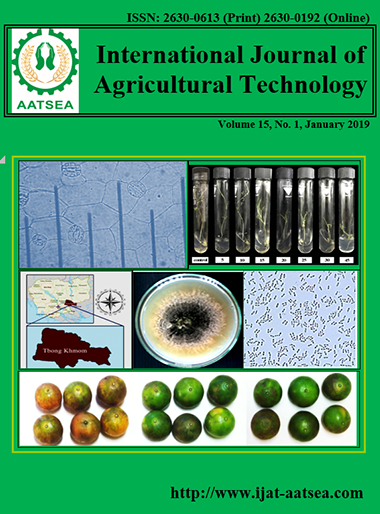The contamination of toxins produced by naturally occurring fungi in non-chemical rice products
Main Article Content
Abstract
A number of non-chemical products are increasing because customers are more aware of the sources and production processes of the products. One such product is rice, which is the main food source of Thai people. It can be seen that a variety of rice products are from non-chemical processes i.e. without chemical fertilizers and pesticides. However, these products could have naturally occurring toxins produced by fungi. Thus, the contamination of toxins naturally produced was investigated the fungi to ensure the trust of consumers that the products are safe to eat. Thirty-one rice products were randomly collected from retail stores in Muang District, Khon Kaen, Thailand and isolated fungi for molecular identification. The fungi found among the products were Aspergillus syndowii, A. amstelodamii, A. tamari, A. niger, A. aculeatus, A. flavus, A. fumigatus, Fusarium equiseti, Rhizopus oryzae, R. microspores, Trichoderma asperellum, Dendryphiella sp. and Phoma multirostrata. The toxins related to the fungi were quantified using a highly accurate method, High Performance Liquid Chromatography with Fluorescence Detector (HPLC/FLD) in comparison with toxin standards (aflatoxin B1, aflatoxin B2, aflatoxin G1, aflatoxin G2, ochratoxin A, and zearalenone). The result suggested that among 31 samples with undetectable amounts, only one rice sample was contaminated with aflatoxin B1 (<1.5 ug/kg), total aflatoxin (0.66 ug/kg) and zearalenone (0.7 ug/kg).
Article Details

This work is licensed under a Creative Commons Attribution-NonCommercial-NoDerivatives 4.0 International License.
References
Bánáti, H., Darvas, B., Fehér-Tóth, S., Czéh, Á. and Székács, A. (2017). Determination of mycotoxin production of Fusarium species in genetically modified maize varieties by quantitative flow immunocytometry. Tothill IE, (ed.) Toxins 9:70. doi:10.3390/toxins9020070.
Benbrook, C. (2005). Breaking the Mold -- Impacts of Organic and Conventional Farming Systems on Mycotoxins in Food and Livestock Feed. The Organic Center.
Brodal, G., Hofgaard, IS., Eriksen, GS., Bernhoft, A. and Sundheim, L. (2016). Mycotoxins in organically versus conventionally produced cereal grains and some other crops in temperate regions. World Mycotoxin Journal. 9:755-770.
Cantabrana, I., Perise, R. and Hernández, I. (2015). Uses of Rhizopus oryzae in the kitchen. International Journal of Gastronomy and Food Science. 2:103-111.
Cirillo, T., Ritieni, A., Visone, M. and Cocchieri, R. A. (2003). Evaluation of conventional and organic Italian food stuffs for deoxynivalenol and fumonisins B(1) and B(2). Journal of Agricultural and Food Chemistry. 51:8128-8131.
De França, S. K. S., Cardoso, A. F., Castro, D. L., Soares, R. E. M. L., Corsi, D. M. C. and Barata, D. G. (2014). Biocontrol of sheath blight by Trichoderma asperellum in tropical lowland rice. Agronomy for Sustainable Development. 35:317-324.
Doll, S., Valenta, H., Danicke, S. and Flachowsky, G. (2002). Fusarium mycotoxins in conventionally and organically grown grain from Thuringia/Germany. Landbauforschung Volkenrode. 52:91-96.
El_Komy, M. H., Saleh, A. A., Eranthodi, A. and Molan, Y. Y. (2015). Characterization of novel Trichoderma asperellum isolates to select effective biocontrol agents against tomato Fusarium wilt. The Plant Pathology Journal. 31:50-60. http://doi.org/10.5423/PPJ.OA.09.2014.0087.
Felsenstein, J. (1985). Confidence limits on phylogenies: An approach using the bootstrap. Evolution. 39:783-791.
Jukes, T. H. and Cantor, C. R. (1969). Evolution of protein molecules. In Munro HN, editor, Mammalian Protein Metabolism, Academic Press: New York. pp. 21-132.
Lapmak, K., Lumyong, S., Wangspa, R. and Sardsud, U. (2009). Diversity of filamentous fungi on brown rice from Pattalung Province, Thailand. Journal of Agricultural Technology. 5:129-142.
Lazzaro, I., Moretti, A., Giorni, P., Brera, C. and Battilani, P. (2015). Organic vs conventional farming: Differences in infection by mycotoxin-producing fungi on maize and wheat in Northern and Central Italy. Crop Protection. 72:22-30.
Nei, M. and Kumar, S. (2000). Molecular Evolution and Phylogenetics. Oxford University Press:New York.
Office of Agricultural Economics (2014). Thailand Agriculture Statistics 2014. Accessed on 17July 2559. http://www.oae.go.th/download/download_journal/2558/yearbook57.pdf.
Office of Agricultural Economics (2013). Agriculture products forecast 29:167. ISSN 0858-836 http://www.oae.go.th/download/forecast/journalofsep2557forecast.pdf.
Panrapee, I., Phakpoom, K., Thanapoom, M., Nampeung, A. and Warapa, M. (2016). Exposure to aflatoxin B1 in Thailand by consumption of brown and color rice. Mycotoxin Research 32:19–25. DOI 10.1007/s12550-015-0236-4.
Pasanen, AL., Kalliokoski, P., Pasanen, P., Jantunen, MJ. and Nevalainen, A. (1991). Healthy buildings laboratory studies on the relationship between fungal growth and atmospheric temperature and humidity. Environment International. 17:225-228.
Riker, A. J. and Riker, R. S. (1936). Introduction to Research on Plant Disease. John S. Swift Co., St. Louis. Mo. pp.117.
Tamura, K., Stecher, G., Peterson, D., Filipski, A. and Kumar, S. (2013). MEGA6: Molecular evolutionary genetics analysis version 6.0. Molecular Phylogenetics and Evolution. 30: 2725-2729. doi: 10.1093/molbev/mst197.
Trung, T. S., Bailly, J. D., Querin, A., Le Bars, P. and Guerre, P. (2001). Fungal contamination of rice from southVietnam, mycotoxinogenesis of selected strains and residues in rice. Revue de Médecine Vétérinaire. 152:555-560.
Varga, J. Baranyi, N., Chandrasekaran, M., Vágvölgyi, C. and Kocsubé, S. (2015). Mycotoxin producers in the Aspergillus genus: an update. Acta Biologica Szegediensis. 9:151-167.
Viriyangkul, L. (2014). Individual study: The management of rice products towards thailand’s food sustainability. Ministry of Foreign Affairs.
White, T. J., Bruns, T., Lee S. and Taylor, J. (1990). Amplification and direct sequencing of fungal ribosomal RNA genes for phylogenetics. p. 315-322. In: Innis M.A., Gelfand D.H., Sninsky J.J. and White T.J., (Eds): PCR Protocols: a guide to methods and applications. San Diego:Academic Press.


